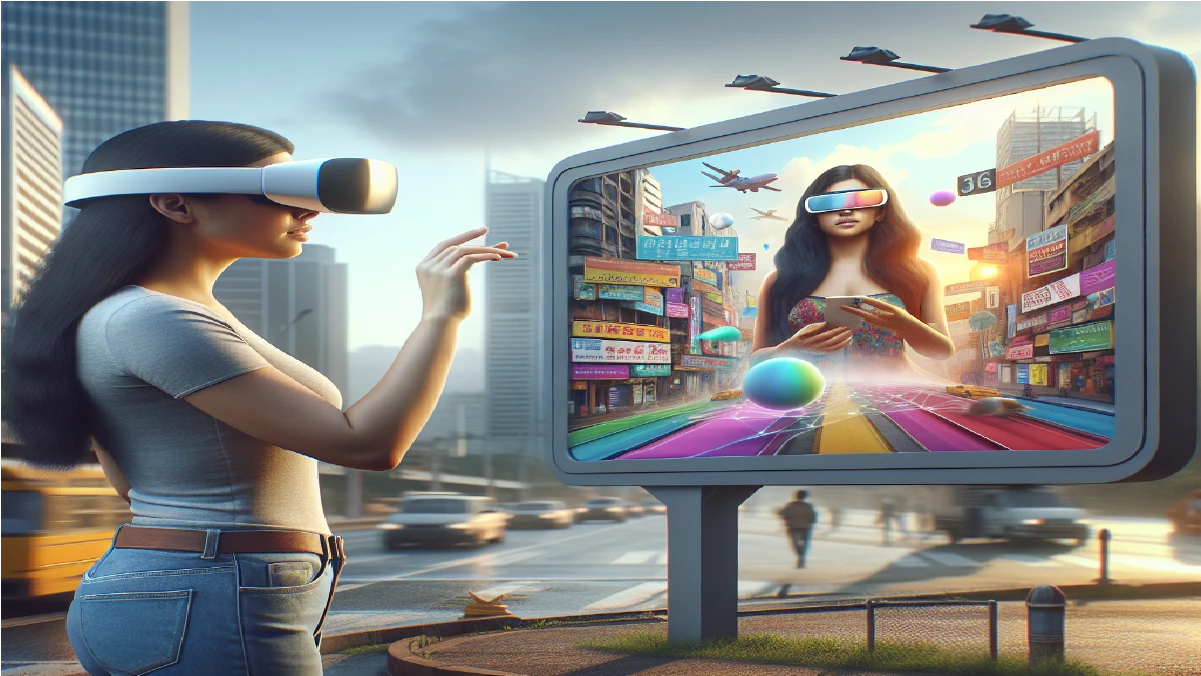Table of contents
In today’s fast-paced digital world, innovation is the cornerstone of impactful advertising. Among the most exciting technological advancements reshaping the industry is Augmented Reality (AR). AR merges the digital and physical realms, creating immersive experiences that captivate audiences like never before. With the global AR market projected to reach unprecedented heights, advertising is poised to become more interactive, engaging, and personalized. Let’s dive into how AR is revolutionizing the advertising landscape.
Understanding Augmented Reality

Augmented Reality is a technology that overlays digital information onto the user’s view of the real world. This can include images, videos, 3D models, and data, all seamlessly integrated through devices such as smartphones, tablets, or specialized AR glasses. Unlike Virtual Reality (VR), which creates a completely artificial environment, AR enhances the real-world setting with digital components, offering a unique and interactive user experience.
AR Advertising: Engaging Consumers on a New Level
AR advertising has emerged as a game-changer in the marketing world. By superimposing digital content onto real-world environments, brands can create rich, engaging narratives that resonate deeply with consumers. Imagine trying on a pair of sunglasses or watching a car spin and whirl through the streets, all from the comfort of your home—this is the power of AR advertising.
Interactive Campaigns
One of the most significant advantages of AR advertising is the ability to create interactive campaigns. Consumers can engage with products in a way that was previously impossible with static ads. Interactive AR ads invite users to become part of the story, offering a hands-on experience that can personalize the product and make a memorable impression.
Personalization and Customization
By harnessing AR, advertisers can offer personalized content tailored to the individual’s preferences, location, and behavior. This customization can significantly enhance the consumer’s connection with the brand, driving both loyalty and sales. For example, a fashion retailer can use AR to show how a dress would look on a shopper, transforming the traditional online shopping experience into something much more personal and engaging.
Memorable Experiences
The immersive nature of AR advertising means that campaigns are more likely to leave a lasting impression. Brands can create memorable experiences, such as virtual try-ons, immersive product demonstrations, or interactive games that not only entertain but also educate about the product.
The Benefits of AR Advertising for Brands
Augmented Reality is not just a novelty; it presents tangible benefits for both businesses and consumers. Brands that leverage AR in their advertising can expect to reap several rewards.
Elevated Engagement
Engagement levels with AR are typically much higher than with traditional advertising. By offering an experience that’s both fun and informative, brands can increase the time consumers spend with their content, which can ultimately translate to better brand recall and affinity.
Enhanced Conversion Rates
Virtual try-ons, product demos, and other AR features can reduce the uncertainty often associated with online shopping. This can increase consumer confidence, leading to higher conversion rates and reduced return rates for e-commerce businesses.
Innovative Brand Image
Employing AR technologies in advertising campaigns signals to consumers that a brand is forward-thinking and innovative. This perception can be particularly important for tech-savvy and younger demographics who are looking for brands that push the envelope and embrace cutting-edge technology.
Challenges and Considerations
Despite its potential, AR advertising does face challenges. Ensuring that the technology is accessible and provides a seamless experience can be a hurdle for some brands. Furthermore, creating high-quality AR content can be resource-intensive. It involves a mix of creativity and technical expertise that may require new talent or partnerships with specialized firms.
Privacy is another consideration, as AR ads can collect personal data to personalize experiences. Brands must navigate regulations and ethical considerations to maintain consumer trust.
Future of AR in Advertising
The future of AR advertising is bright, with continuous innovations broadening the scope of what’s possible. As AR technology becomes more widespread and accessible, we can expect even more creative and engaging ad campaigns that blur the lines between reality and digital enhancement.
Advancements in AR Technology
Ongoing developments in AR tech, such as improved tracking, facial recognition, and machine learning, will enable more sophisticated and intuitive AR experiences. The arrival of wearable AR devices, like smart glasses, will further integrate AR into everyday life, creating new opportunities for advertisers to reach potential customers.
Integration with Other Technologies
Augmented Reality is increasingly being combined with other emerging technologies like Artificial Intelligence (AI), the Internet of Things (IoT), and 5G networks. These converging technologies will empower advertisers to create more dynamic, context-aware campaigns that engage consumers in real-time.
The Rise of Social AR
Social media platforms have embraced AR, introducing filters and effects that users can apply to their content. This evolution has opened new avenues for branded AR content that audiences can share and promote organically, creating a viral effect.
Conclusion
Augmented Reality advertising represents a frontier brimming with potential, offering an unprecedented way to merge creative storytelling with user interactivity. As AR technology continues to evolve and become more ingrained in our daily lives, advertisers who embrace its capabilities will be able to craft compelling, personalized experiences that resonate strongly with consumers. The possibilities are limitless, and the stage is set for a transformative impact on advertising as we know it. Whether it’s through a virtual try-on, an interactive game, or a 3D product demo popping up in your living room, AR advertising isn’t just the future—it’s the present, revolutionizing the industry one augmented experience at a time.



